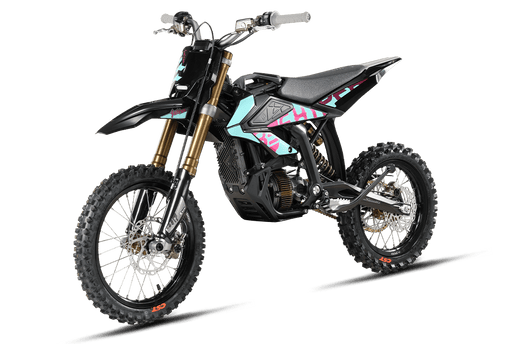Surron 48V batteries are advanced lithium-ion power units optimized for electric motorcycles, employing multiple 3.7V cells in series to achieve 48V nominal voltage. Designed for energy density and rapid discharge, they integrate a battery management system (BMS) to regulate charging cycles, prevent thermal runaway, and balance cell voltages. These batteries deliver instant torque for acceleration and recover energy during braking, enhancing range. Pro Tip: Always use Surron-approved chargers to maintain BMS calibration and avoid capacity fade.
Where Can I Rent a Surron in Dubai?
What are the core components of a Surron 48V battery?
A Surron 48V lithium-ion battery comprises 13–14 series-connected cells, a BMS monitoring voltage/temperature, and aluminum casing for thermal dissipation. Cells like NMC or LiFePO4 enable 2,000+ cycles at 80% DOD.
Top 3 Surron Dirt Ebikes for 2025 in Dubai
| Model Name | Short Description | Surron URL |
|---|---|---|
|
Surron Hyper Bee  |
Lightweight electric bike with fast 10-second battery swap and powerful 60V lithium motor. | Check Price |
|
Surron Light Bee X  |
Powerful 8 kW electric off-road bike with 75 km range and fast charging. | Check Price |
|
Surron Ultra Bee  |
Powerful 12.5KW motor, 140 km range, 74V 55AH battery, fast charging, all-terrain ready. | Check Price |
Beyond basic chemistry, the BMS acts as the system’s brain. It tracks individual cell voltages with ±20mV precision, disconnecting the load if temperatures exceed 60°C. The casing uses ribbed designs to maximize surface area, passively cooling during high-current demands. For example, Surron’s Light Bee X battery achieves 25Ah capacity through prismatic cells stacked vertically. Pro Tip: Regularly check BMS connectors for corrosion—oxidation disrupts voltage sensing and triggers false error codes.
How does energy flow in Surron’s 48V system?
Energy flows bidirectionally: discharging during acceleration and regenerative braking recharges cells. The controller modulates currents up to 80A for peak power.
During acceleration, the battery’s 48V output feeds the motor controller, which converts DC to three-phase AC for the motor. Practically speaking, 40–50% of braking energy gets reclaimed through regen—adding ~8% range in urban riding. Surron Dubai technicians note that Ultra Bee models optimize this via adaptive throttle mapping. But what happens if regen is too aggressive? Sudden deceleration strains cell anodes, so Surron’s BMS limits recharge rates to 0.5C. Pro Tip: Use Eco mode for smoother regen transitions, preserving cell health over time.
| Phase | Current | Voltage Range |
|---|---|---|
| Acceleration | 50–80A | 54.6V–48V |
| Regen | 15–25A | 48V–52V |
Why choose lithium-ion over lead-acid in 48V systems?
Lithium-ion offers 4x energy density and half the weight of lead-acid, crucial for agile motorcycles. Surron batteries maintain 90% capacity after 1,500 cycles versus 300 cycles for AGM.
Lead-acid’s 30Wh/kg limits performance, while Surron’s LiFePO4 cells provide 120Wh/kg. This weight reduction lowers the Light Bee’s center of gravity, improving trail handling. However, lithium-ion requires precise charging. For instance, Surron chargers apply 54.6V CV phases to prevent overvoltage. Pro Tip: Store batteries at 40–60% charge if idle >1 month—full charges accelerate electrolyte degradation.
What role does the BMS play in Surron batteries?
The BMS ensures cell balance, overcurrent protection, and temperature management. It communicates fault codes via CAN bus to the dashboard.
By redistributing energy between cells, the BMS minimizes voltage deviation (<3%). During faults like a short circuit, it cuts output in <100ms. Surron Dubai’s diagnostic tools reset BMS errors like P0606 (internal processor fault), often caused by voltage spikes. Pro Tip: Update firmware annually via Surron service centers to enhance BMS algorithms.
| Parameter | Threshold | Action |
|---|---|---|
| Cell Voltage | <3.0V or >4.25V | Disconnect Load |
| Temperature | >60°C | Reduce Current by 50% |
How does temperature affect Surron 48V performance?
Below 0°C, lithium-ion conductivity drops by 30%, limiting regenerative braking. Surron’s BMS preheats cells using 20W internal heaters when temps fall below 5°C.
In Dubai’s heat, thermal pads transfer heat from cells to the casing, maintaining <45°C at 35°C ambient. But what if you leave the bike in direct sunlight? Prolonged exposure above 50°C accelerates SEI layer growth, permanently increasing internal resistance. Surron Dubai advises parking in shade and using thermal battery blankets during summer storage.
Surron Dubai Expert Insight
How Can I Finance a Surron Storm Bee in Dubai?
FAQs
No—the motor and controller aren’t rated for 72V. Upgrading voids warranty and risks component failure.
How long does a Surron 48V battery last?
3–5 years with proper care. Avoid full discharges—keep charge above 20% for maximum cycle life.
Is fast charging safe for Surron batteries?
Yes, using official 10A chargers. Third-party >15A chargers degrade cells 30% faster.